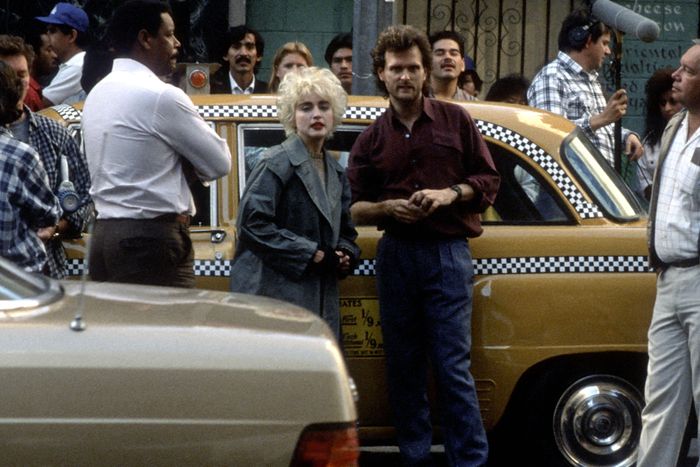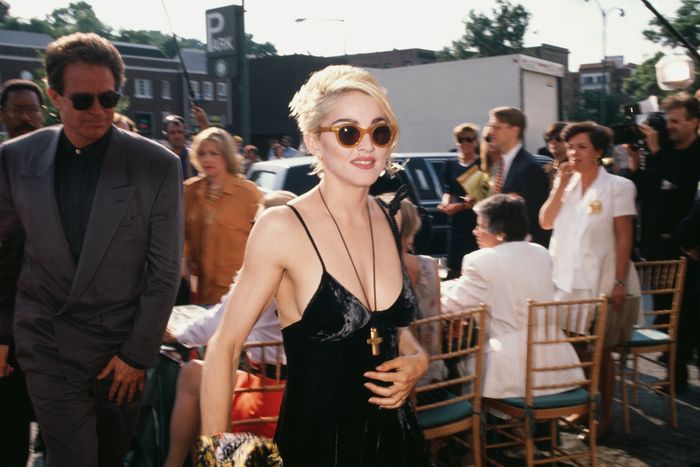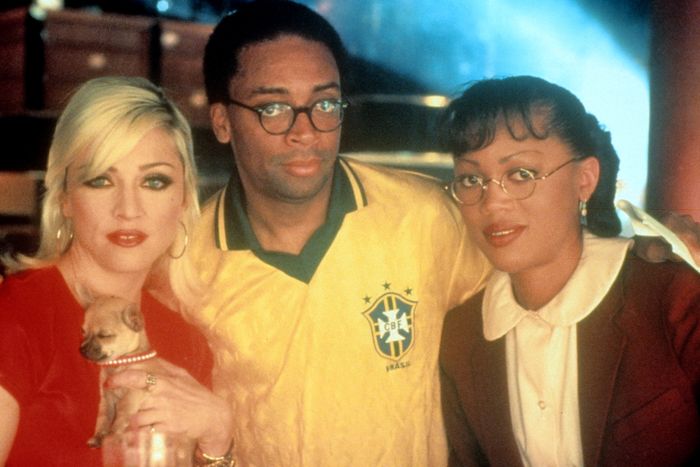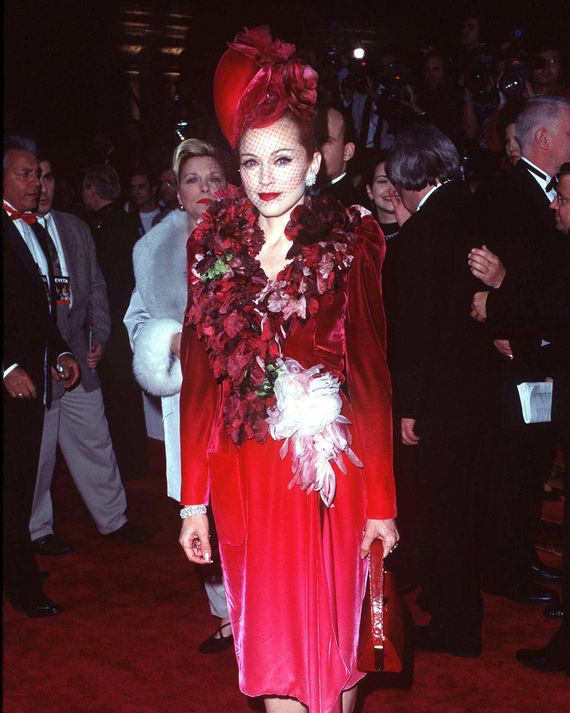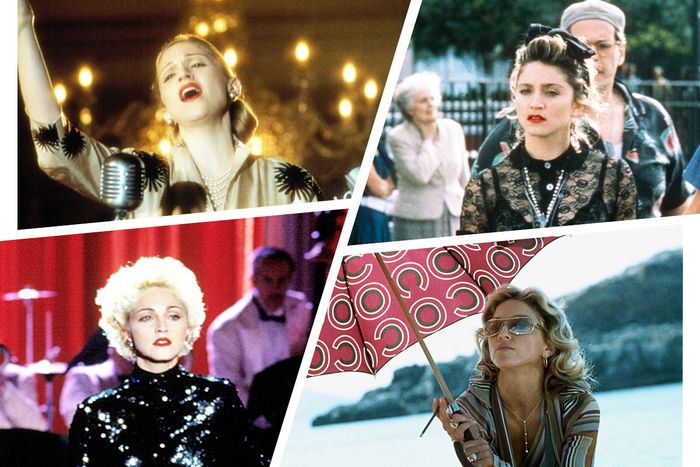
“I just don’t think people are comfortable with me doing well in other areas besides music,” Madonna told Matt Lauer when he asked her about the misadventure of Swept Away. The notorious 2001 flop, directed by her then-husband Guy Ritchie, effectively ended Madonna’s acting career — though not, she said, for lack of offers. Over the years, Madonna had accepted some blame for her big-screen seesawing, admitting in 1991 that she sometimes chose projects hastily. “I’ve been a failure so far,” she said, even if that wasn’t entirely true (see: Desperately Seeking Susan, Dick Tracy). But on the day Lauer inquired about her critics, Madonna was feeling defiant. Did the nine-time Razzie winner think she was a good actress? “Yeah, I do,” she told him.
Madonna had the receipts: Susan, A League of Their Own, her Golden Globe–winning turn in Evita, the hilarious “Coffee Talk” sketch from Saturday Night Live, her cameo in Girl 6. Great performances, all of them. Still, it was hard to argue with the skeptics who lambasted her flat characterization in Shanghai Surprise, her stilted delivery in Body of Evidence, or her quasi-British uppityness in The Next Best Thing. The public was so content to tarnish her movie work that even the best of it was often received with caveats: It’s good, you know, for a Madonna performance. Had she found more directors like Susan Seidelman, Penny Marshall, Spike Lee, and Alan Parker, maybe she could have steered that lore in a different direction.
Madonna recently wrapped the Celebration Tour, the first roadshow built around her greatest hits. It is by no means a formal good-bye — as if Madonna would quit, even at 65 — but her willingness to encapsulate 42 years’ worth of music after refusing for so long to become a nostalgia act carries a wistful bent. Unlike every other aspect of her life, however, Madonna’s movies went largely unacknowledged during the tour’s retrospective video montages. (Even her ex-boyfriends got a slideshow.) But when her dancers flooded the stage in famous Madonna looks for the closing number, one of them wore the League of Their Own baseball uniform. She knows a greatest hit when she sees one.
And what about the other films? Vulture decided to call up a handful of her Hollywood collaborators to collect anecdotes. Not every title is featured here — if you want more about League, for example, grab Erin Carlson’s fun behind-the-scenes book — but we’ve compiled details that exemplify Madonna’s drive, including insight into two roles that never came to be.
An early coercion: Desperately Seeking Susan (1985)
Today, it’s easy to think of Desperately Seeking Susan as stunt casting — a cool, charismatic New Yorker playing a cool, charismatic New Yorker who looks and operates a lot like Madonna herself. But when director Susan Seidelman suggested her for the movie’s eponymous downtown urchin, Madonna’s face wasn’t yet implanted in everyone’s cerebral cortex. She hadn’t yet stunned primetime-TV viewers by rolling around the VMAs stage in a cheeky wedding dress, and according to casting director Risa Brannon Garcia, the executives at Orion Pictures had no strong feelings either way about Madonna’s commercial value.
Madonna, on the other hand, had a lot of feelings about her value — and who she wanted to surround it. Brannon Garcia and her casting partner Billy Hopkins had pinpointed four actors who could play Madonna’s boyfriend, a punk rocker hitting the road with his band. After seeing the audition tapes, Madonna asked them to hire Robert Joy, who was fresh off Miloš Forman’s Ragtime and had the streetwise composure she envisioned. Brannon Garcia told her she’d need to screen-test with the men to see if Joy really was the right choice.
“She went and read with them all, and she put her heart and soul into this thing that she did with Bob,” Brannon Garcia says. “She was more present, in the best sense of the word, than I’d ever seen her. It was a kissing scene, and she went after him in a way that made their chemistry undeniable. Not that she tanked the other guys, but she didn’t have the same level of presence and commitment that she did with Bob. It was very clear that she wanted what she wanted and she was going to make that happen.”
An unwelcome run-in: Who’s That Girl (1987)
Long before Gigli or By the Sea, there was Shanghai Surprise, another high-profile bomb involving the most famous couple of its day — newlyweds Madonna and Sean Penn. Anxious to distance herself from that movie, which MGM reportedly recut against director Jim Goddard’s wishes, Madonna turned her attention to playing Nikki Finn, her savvy parolee in the screwball comedy Who’s That Girl. In addition to Griffin Dunne and a live cougar, Madonna got to work with her friend James Foley, whose couch Penn was crashing on when the men first met the singer while visiting the set of her “Material Girl” video. (Foley served as best man at the pair’s wedding and directed three Madonna videos, including “Papa Don’t Preach.”)
Later, he also did something few can claim: He forced Madonna to grovel. Foley was planning to shoot a scene in front of Trump Tower on Fifth Avenue, and Donald Trump apparently stipulated that he wanted a paparazzo shot with her in hopes of making the New York Post. Madonna initially refused, launching years of scorn directed at the real-estate cheat. (“He’s a wimp,” she told Interview in 1990 when asked about his budding presidential prospects.) But Foley insisted, knowing that Warner Bros. had already negotiated access to the building. “It was one of those moments where I had to say, ‘You gotta do this,’” he says. “I don’t think she made eye contact with him.”
A Bette Midler forerunner: Ruthless People
Co-directors David Zucker, Jerry Zucker, and Jim Abrahams had just made Airplane! and Top Secret! when Disney chiefs Jeffrey Katzenberg and Michael Eisner encouraged them to meet with Madonna for what would become Bette Midler’s role in the 1986 kidnapping comedy Ruthless People. “At that dinner, we were all mesmerized by her,” Jerry says. It would have been an opportunity for Madonna to go over-the-top, to kick and scream and scheme. But something didn’t click. The audience needed to believe her husband hated her, and Madonna showed too much charm to drive a man away. Plus, at 27, she still seemed a bit young to play a housewife. Eventually, everyone agreed it wasn’t the right fit.
An ode to Old Hollywood: Dick Tracy (1990)
Jeffrey Hornaday, the choreographer who made his name on Flashdance and Romancing the Stone, first met Madonna when she auditioned for 1985’s A Chorus Line, mere months after her debut album came out. Hornaday later worked on some of Madonna’s tours, so it was kismet when Warren Beatty hired him to choreograph Dick Tracy and later announced that he’d chosen Madonna to play vixen Breathless Mahoney. This was the closest Madonna had come to real Hollywood greatness: She was recording with Stephen Sondheim and starring opposite Beatty, Mandy Patinkin, and Al Pacino. It also gave her a new beau in Beatty. “They were discreet about it, but you could tell they had a real romantic chemistry,” Hornaday recalls. “I think it worked for the movie.”
Pacino being Pacino, he came to rehearsals in character as Big Boy, the hunchbacked live wire who barks stage directions as Breathless practices the 1920s-style cabaret number “More.” Hornaday and Madonna had choreographed the song in full, then deconstructed it so it would seem like a work in progress. Beatty gave Pacino license to improvise, Hornaday says, meaning he could drive Madonna up the wall however he wanted. “Musicals were a totally foreign world to him, so I think it was a way for him to feel more free and not become self-conscious,” Hornaday says. Big Boy hollered at Breathless, mocked her, pushed her, and taunted her chorus girls. Madonna took it like a champ; this was easy compared to Sondheim, who pushed her to vocal acrobatics she had never before attempted. “He’s very demanding and very specific about how things should go,” Hornaday says of the Broadway legend. “It was a huge challenge for her emotionally, and he was totally happy with her.”
An auteur cameo: Girl 6 (1996)
Spike Lee and his wife, attorney turned wellness entrepreneur Tanya Lewis, have been married for 31 years. Their first date was the October 1992 release party for Sex, Madonna’s scandalous soft-core pornography book; they wed one year later. Lee and Madonna had hung out on and off as creatures of New York’s creative class. When he cast her longtime friend Debi Mazar in the underrated Girl 6 as a phone-sex operator employed at the call center where an aspiring actress (Theresa Randle) finds work, Lee thought, Why not get Madonna, too? It was a small role, just a couple of days on set, and it couldn’t have fit her better. Madonna plays a well-manicured superior who rattles off the various acts callers might request. (“Shitting’s really big right now. Don’t ask me why. Could be the stock market.”)
After the back-to-back bombs Body of Evidence and Dangerous Game, casting Madonna wasn’t exactly in vogue. “I didn’t give a fuck,” Lee says. “She’s who I had in mind, and she wanted to do it, so that was it. She’s a pro.” Ever since, they’ve had a symbiotic back-and-forth. Madonna’s team gave Lee a discount on a couple of Ray of Light tracks he wanted to use in his Netflix adaptation of She’s Gotta Have It, and he gave her feedback on the script for the since-canned biopic that she was going to direct about herself. Lee says she also gave him a friendly talking-to when his son, Jackson, was apparently pursuing Madonna’s daughter, Lourdes. “She said, ‘Spike, your son is bothering my daughter,’” Lee laughs.
A future Best Picture winner: Chicago
Before Renée Zellweger and Catherine Zeta-Jones, there was Goldie Hawn and Madonna. The two superstars were up for Roxie Hart and Velma Kelly in Chicago, which spent years in development at Miramax. Before director Rob Marshall gave it all that jazz, Harvey Weinstein courted a score of writers and directors, according to producer Meryl Poster: Tootsie scribe Larry Gelbart, Robert Iscove (fresh off Brandy’s Cinderella), Curtis Hanson, and former Madonna collaborator David Fincher. Stanley Donen, the storied director of Singin’ in the Rain and Funny Face, attached himself, after which Weinstein asked him to meet with Hawn and Madonna. (Miramax had released Madonna’s blockbuster 1991 documentary Truth or Dare.) Weinstein also floated the idea of casting Janet Jackson, Poster says, but it never went anywhere. Imagine Chicago starring Janet and Madonna!
When Donen later backed out, the film went to Nicholas Hytner, a theater veteran who had recently directed The Madness of King George. Hytner thought Hawn, who was nearly 50, had aged out of playing a wannabe starlet like Roxie; he sought out up-and-comer Charlize Theron instead. Months passed while Miramax sorted through the development. Eventually, Madonna dropped out to play a violin teacher in Music of the Heart, only to clash with Wes Craven and leave that movie, too. When Marshall pitched his vision of Chicago — framing Roxie’s musical numbers as fantasy sequences — Miramax decided to start the casting process from scratch.
Along the way, Madonna and Poster had become friends — so much so that Madonna expected to attend Poster’s wedding. But Poster had already invited the dreamboat John F. Kennedy Jr., to whom Madonna was romantically linked (erroneously, Poster promises) in the late ’80s. Poster told Madonna she couldn’t come. “I was not having her at my wedding!” she says. Fortunately, Madonna took it well, sending Poster a “really cool” pair of Gualtier shoes as a gift.
A marketing gamble: Evita (1996)
Alan Parker’s long-gestating adaptation of Andrew Lloyd Webber and Tim Rice’s musical was a study in contradictions. Can the author of the Sex book headline a classy Disney-backed biopic about Argentine first lady Eva Perón? Meryl Streep, who had left the movie over a compensation dispute, didn’t mince words: “I could rip her throat out,” she told the New York Times. “I can sing better than she can, if that counts for anything.” Purists wanted Patti LuPone, who originated the role on Broadway, but she didn’t have much name value on the big screen, especially at a time when movie musicals were passé. (Four short years earlier, Disney’s Newsies crashed at the box office.) For Madonna, who lobbied hard to get the part, a rebrand was in order.
“We had this really candid conversation with Liz Rosenberg,” says a former Disney marketing executive, referring to Madonna’s former longtime publicist, “and said, ‘She’s going to have to transform over the next year.’ If you go back and look at what she wore to public events, she was sort of buttoned-up. Liz saw the wisdom in an image shift.”
According to Peter Adee, another Disney marketing veteran, Madonna was one step ahead of Rosenberg. She understood that softening the reputation that Sex and the R-rated album Erotica had given her a few years earlier was essential to winning over highbrow Hollywood types, especially because gossip hounds were calling her first pregnancy a PR stunt. (“Some people have suggested that I have done this for shock value,” she said. “These are comments only a man would make. It’s much too difficult to be pregnant and bring a child into this world to do it for whimsical or provocative reasons.”) Disney sold Evita as an elegant love story above all else, and Madonna partnered with fashion brands like Bloomingdale’s, Dior, Ferragamo, and Estée Lauder for in-store displays and cosmetic lines that gave the campaign an upscale sheen. She weighed in on every detail. Forever indebted to the Old Hollywood luminaries she idolized, Madonna remade herself the way Elizabeth Taylor would have. “There are times in advertising where you wink, wink, nod, nod — you make fun of it,” Addee says, referring to Madonna’s spotty acting résumé. “We never did. We sold it as Evita starring Madonna, basically saying, ‘This is something new.’”
A final ride: Swept Away (2001)
At lunch, they wrestled. Not Madonna, but her director-husband Guy Ritchie, a bloke’s bloke who challenged crew members and anyone else who was willing — any man, at least — to midday wrestling matches. Bruce Greenwood, playing Madonna’s millionaire husband in Ritchie’s ill-fated remake of the 1974 Lena Wertmüller art-house classic, declined. “I said, ‘No, thank you, I’m gonna have my burrito,’” Greenwood recalls. “It was proper wrestling, like ‘submit-or-get-hurt’ wrestling. A lot of the guys were really into it.”
Swept Away would be Madonna’s final starring role. It flopped hard enough for her to throw in the movie towel. Greenwood spent a month shooting in Malta, and despite the Razzie-friendly reputation it immediately developed, he has pleasant memories. He also witnessed firsthand one of the globe’s most recognizable couples in action, having first visited their Los Angeles house, where Ritchie clobbered him in a game of chess. “They were really playful in a cantankerous kind of way,” he says. “Just taking the piss out of each other, but in a healthy way. Neither of them are shrinking violets. Their energy was ribbing each other.”
Despite her bullishness when Matt Lauer broached the subject, Madonna clearly internalized the outcome of Swept Away, which, after much ridicule, barely grossed $1 million worldwide. Her acting career was officially over. “I hate to admit it, but I’ve decided to give that up,” she said in 2006. “How can any film survive if everyone says it’s going to be a flop from the very day the project is even conceived? It’s already dead in the water. To continue to try to do films with the knowledge that everyone will just spit on them — and enjoy doing so — just doesn’t make sense to me any more.”


